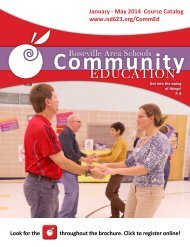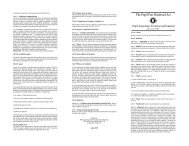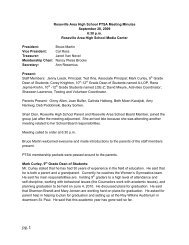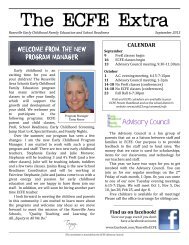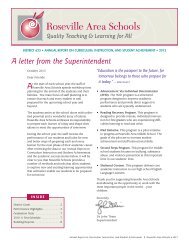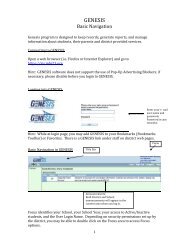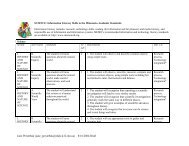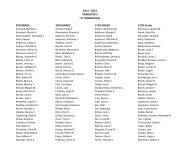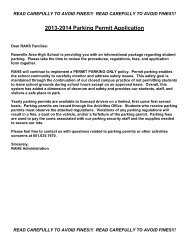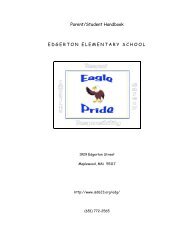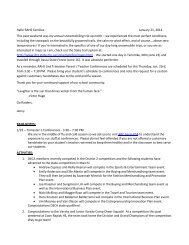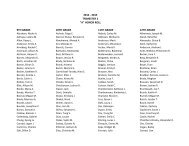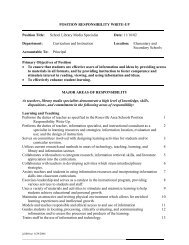Roseville Area Schools Local Literacy Plan for Reading Well by ...
Roseville Area Schools Local Literacy Plan for Reading Well by ...
Roseville Area Schools Local Literacy Plan for Reading Well by ...
Create successful ePaper yourself
Turn your PDF publications into a flip-book with our unique Google optimized e-Paper software.
eading. This assessment is conducted in the winter and spring <strong>for</strong> students in kindergarten, in<br />
the fall, winter and spring <strong>for</strong> students in grade one, and is conducted at minimum in the fall and<br />
spring in grades two and three.<br />
Teachers use established district expectations to identify which students are predicted to be<br />
below grade level expectations <strong>by</strong> the spring of that school year based on assessment<br />
in<strong>for</strong>mation from the BAS. This data is shared with parents during winter conferences in grades<br />
K-3.<br />
For students in kindergarten, teachers conduct a series of assessments that measure student’s<br />
letter name and sound recognition and sight word recognition in the fall and winter, as well as<br />
phonemic awareness assessments. These assessments identify students <strong>for</strong> whom we suspect<br />
reading difficulty so that Tier II support can be offered to those children. This assessment data is<br />
shared with parents during the fall conference time. In first grade, 20% of the lowest<br />
per<strong>for</strong>ming first grade students are assessed using the Observation Survey <strong>by</strong> Marie Clay. These<br />
students are assessed in the fall and again in the winter. This data is used to determine which<br />
first grade students will receive <strong>Reading</strong> Recovery, a Tier III intervention, typically lasting <strong>for</strong> 12-<br />
14 weeks, that is supplemental to Tier I and Tier II instruction. This assessment data is shared<br />
with parents when their child begins <strong>Reading</strong> Recovery instruction. In second and third grade<br />
students take the NWEA-MAP test in reading in the fall, winter and spring. Teachers use the<br />
in<strong>for</strong>mation from the MAP test to identify students who score at or below the 33% in reading.<br />
Those students are then targeted <strong>for</strong> Tier II and Tier III intervention support. MAP testing data<br />
is sent home with students in the fall, and shared with parents at winter conferences.<br />
Once students have been identified as being as risk <strong>for</strong> not reaching grade level proficiency,<br />
Collaborative Intervention <strong>Plan</strong>s (CIP’s) are created which are designed to establish shared goals,<br />
intervention plans, progress monitoring and communication between all teachers involved in a<br />
child’s instruction. The intervention plans target specific reading skills and behaviors that<br />
teachers need to accelerate in order <strong>for</strong> the child to achieve proficiency. These plans are<br />
collaboratively developed <strong>by</strong> teams of teachers at that grade level. Progress monitoring is a<br />
critical element of the intervention plan, in order to evaluate the effectiveness of the<br />
interventions. The CIP is reviewed every 6-10 weeks, and progress monitoring data is used to<br />
determine if the interventions are successfully accelerating the student’s reading progress at a<br />
minimum of double growth.



